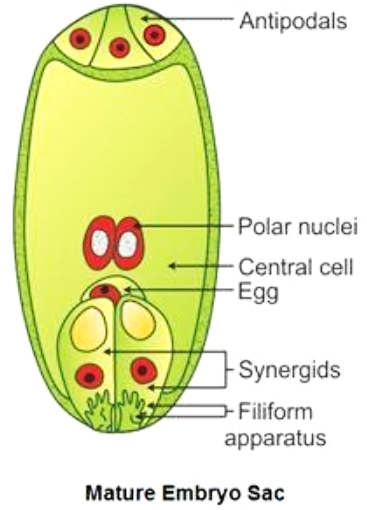
Draw and describe the structure of a mature embryo sac of angiosperm.
Answer
507.3k+ views
Hint The structure of the mature embryo sac consists of 8 nucleated and 7 celled structures. It has two ends that contain its components. It is the female gametophyte of the flowering plant.
Complete answer:

The typically mature embryo sac of an angiosperm consists of two ends that are the chalazal end and another one is the micropylar end. At the micropylar end, there are two cells called synergids cells with an egg apparatus.
The two synergid cells contain filiform apparatus like element which helps in guiding the pollen tubes entry in the embryo sac during the event of fertilization. It also helps to stimulate the division and another function of filiform is to produce lots of nectar and also to identify the pollen at the very stage of stigma. Filiform also helps in the transfer absorption of the nutrients from the Nucellus into the embryo sac. In the chalazal end, there is a presence of three antipodal cells. When we see at the middle portion that means the between of the two ends there is a presence of two polar nuclei.
The function of these two polar nuclei is to fuse, which will happen before the fertilization and form the diploid secondary nucleus. So eight nuclei are being present in seven cells that’s why the embryo sac is called 7 celled and eight nucleated.
Note: The embryo sac in the angiosperms is haploid, the zygote is diploid and endosperm is triploid. It is developed from the megaspore mother cell after meiosis and that is why it is haploid. Monosporic is the common type of embryo sac in the angiosperms.
Complete answer:

The typically mature embryo sac of an angiosperm consists of two ends that are the chalazal end and another one is the micropylar end. At the micropylar end, there are two cells called synergids cells with an egg apparatus.
The two synergid cells contain filiform apparatus like element which helps in guiding the pollen tubes entry in the embryo sac during the event of fertilization. It also helps to stimulate the division and another function of filiform is to produce lots of nectar and also to identify the pollen at the very stage of stigma. Filiform also helps in the transfer absorption of the nutrients from the Nucellus into the embryo sac. In the chalazal end, there is a presence of three antipodal cells. When we see at the middle portion that means the between of the two ends there is a presence of two polar nuclei.
The function of these two polar nuclei is to fuse, which will happen before the fertilization and form the diploid secondary nucleus. So eight nuclei are being present in seven cells that’s why the embryo sac is called 7 celled and eight nucleated.
Note: The embryo sac in the angiosperms is haploid, the zygote is diploid and endosperm is triploid. It is developed from the megaspore mother cell after meiosis and that is why it is haploid. Monosporic is the common type of embryo sac in the angiosperms.
Recently Updated Pages
Master Class 12 Business Studies: Engaging Questions & Answers for Success

Master Class 12 Social Science: Engaging Questions & Answers for Success

Master Class 12 English: Engaging Questions & Answers for Success

Master Class 12 Chemistry: Engaging Questions & Answers for Success

Class 12 Question and Answer - Your Ultimate Solutions Guide

Master Class 12 Economics: Engaging Questions & Answers for Success

Trending doubts
What are the major means of transport Explain each class 12 social science CBSE

Which are the Top 10 Largest Countries of the World?

Draw a labelled sketch of the human eye class 12 physics CBSE

How much time does it take to bleed after eating p class 12 biology CBSE

Explain sex determination in humans with line diag class 12 biology CBSE

When was the first election held in India a 194748 class 12 sst CBSE




